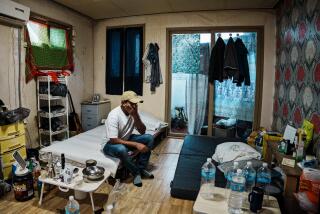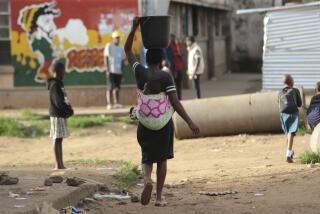Fears of another Darfur
The tranquil Nubian villages along this Nile River stretch are best known for the brightly painted gates that adorn many of the simple mud-brick homes. With geometric shapes and hieroglyphic-like pictures, the oversized gates hark back to the stone-carved doorways the villagers’ ancestors once built on pyramids that rivaled Egypt’s.
These days, however, the elaborate entryways are shadowed by black flags. Government soldiers patrol once-quiet dirt streets, occasionally drawing stones from angry youths. Protest graffiti mar the walls, including one scrawling of an AK-47 with the simple caption: “Darfur 2.”
First, southern Sudan erupted in a 20-year civil war, followed by the east and, most recently, the western region of Darfur. Now many fear that Sudan’s northern territory of Nubia will be the next to explode over the fight for resources and all-too-familiar accusations of “ethnic cleansing” and complaints of marginalization by an Arab-dominated government.
Tensions have been high here since soldiers opened fire on an anti-government protest of 5,000 Nubians in June, killing four young men and wounding nearly two dozen. The government has arrested nearly three dozen Nubian leaders and four journalists who were trying to cover the violence.
Now a recently formed rebel group, calling itself the Kush Liberation Front, is advocating armed resistance to overthrow the central government, which it accuses of oppressing Nubians and other indigenous peoples in Sudan.
“Our efforts will not succeed unless they are backed by military action,” said Abdelwahab Adem, a Nubian former businessman and co-founder of the Kush Liberation Front. “We need to get rid of the Arabs. Our goal is to realize a new Sudan, by force if necessary.”
Adem said the new movement would rely on “guerrilla fighting,” targeting the capital, Khartoum, and other major Sudanese cities. He declined to specify what sort of tactics might be used or how many fighters the group has.
With a separate language and culture, Nubians view themselves as a distinct ethnic group and take pride in being one of Africa’s oldest civilizations. Political observers say the budding movement appears to be taking its cue from the rebellions in Darfur and southern Sudan.
“That’s the lesson of Darfur,” said one Western diplomat in Khartoum, who spoke on condition of anonymity.
“The government will only listen to you when you pick up a gun.”
Darfur rebels are a potential source of weapons and training for the Kush Liberation Front, observers said.
“We have good relations with our brothers in Darfur,” said Adem, who is based in London. But he denied receiving support from the western Sudanese rebels.
The spark for recent unrest was a government proposal to construct two or three electricity-producing dams along the Nile in the Nubian heartland, between the villages of Kajbar, about 350 miles north of Khartoum, and Dal, about 100 miles from the Egyptian border.
This fertile Nile River strip is home to an estimated 300,000 Nubians, many of whom would be forced to relocate if rising river waters swallowed scores of villages.
Also at risk are some of the world’s richest archeological ruins, notably those around the ancient city of Kerma, the first Nubian capital, settled at least 8,000 years ago and lying just downstream from where the proposed 200-megawatt Kajbar dam would be built. The site is home to the oldest known man-made structure in sub-Saharan Africa: a 50-foot, 3,500-year-old mud-brick temple known as the Deffufa.
The proposals come on top of another controversial project, the 1,250-megawatt Merowe Dam, which is already under construction about 150 miles to the east. Flooding from that project will displace 70,000 Arab farmers and engulf several hundred miles of unexplored Nubian archeological sites.
“They want to cut us from our roots and flood all of Nubia and its history,” said Sharif Adeen Ali, 53, a Nubian farmer in the village of Sebu. “They’ve done this before.”
In 1964, construction of the Aswan High Dam in Egypt forced the relocation of 50,000 Sudanese Nubians in the Wadi Halfa region near the Egyptian border and nearly 800,000 Nubians in Egypt.
Nubians see the new dams as a plot by Arab governments in Sudan and Egypt to exterminate their communities and seize the land.
“The two countries have never liked having Nubians, who are not Arabs, in the middle,” said Abdul Halim Sabbar, a former doctor who is part of the Kajbar Dam Resistance Committee.
In Sebu, one of the Nubian communities that would be submerged by the Kajbar dam, once-welcoming residents now peer warily at the parade of unfamiliar trucks and SUVs that speeds through town carrying Chinese engineers to a work site a mile away. Though government officials say they are only conducting a feasibility study, Chinese crews are installing giant cranes, water towers, floodlights and other equipment that suggest to villagers that construction is underway.
On a recent morning, nearly 400 government soldiers marched and drilled at a new military camp set up on the edge of Sebu to protect the Chinese workers. On hills overlooking the village, uniformed lookouts with rifles over their shoulders positioned themselves behind rocks.
“It’s become very tense,” said one villager, who was afraid to be identified. “Many eyes are watching.”
Officials at Sudan’s Dams Implementation Unit declined to comment.
A leader in Sudan’s ruling party defended the dams, contending that they would help the Nubian communities by providing electricity and irrigation for farming.
“It’s going to economically transform the area,” said Osman Khalid Mudawi, foreign affairs chairman in Sudan’s parliament. He estimated that a lake created by the dam would irrigate 750,000 acres of newly arable land.
But some scientists and environmentalists questioned whether the dams would expand food production, noting that the region’s soil is mostly desert sand and granite. Farming is possible only along the riverbanks, thanks to rich silt deposits from the Nile.
A recent report by the United Nations Environmental Program noted that Sudan’s existing dams suffer from declining performance because they are clogged with silt, which has proved difficult to remove. Water loss as a result of the high evaporation rates in the desert heat is another problem. Meanwhile, downstream from the dams, farm production has fallen because the soil is no longer enriched by the silt.
It’s a similar story at the Aswan High Dam, where the lake created by the dam is filling with silt much faster than anticipated and downstream farmers are resorting to artificial fertilizers for the first time.
Nubians argue that the new dams are not intended to provide electricity and irrigation in Sudan, but to rescue the Aswan High Dam by capturing silt before it reaches Egypt. “These dams don’t look at all like development,” said Sabbar, the resistance committee member. “It’s clearly part of a programmed scheme between Egypt and Sudan.”
For decades, Nubians have lived in relative isolation, shunning politics and priding themselves on self-sufficiency. Some years the region found itself entirely left out of the federal budget, which is evident from the lack of paved roads and electricity. Nubians built their own hospitals and schools, though they are still prohibited by law from teaching in their native language.
The threat of renewed flooding, however, has drawn Nubians out of the political desert, and they are mobilizing for a fight.
In addition to demonstrations in Sudan, Nubians abroad are pressing the issue with the United Nations, U.S. State Department and human rights groups such as Amnesty International and Human Rights Watch. They’ve protested at the Sudanese and Chinese embassies in Washington and uploaded graphic footage of the June 13 clashes on the Internet.
“We have more freedom to express ourselves than those still inside Sudan,” said Nuraddin Abdulmannan, a Nubian activist who is heading the resistance committee in Washington. He says it is the duty of the international community to preserve the region’s archeological sites, which include temples and pyramids built when Nubian kings briefly reigned over Egypt’s pharaohs around 730 BC.
“This is an international treasure, and there’s an international responsibility to protect it.”
For many, the June clash with government troops was the final indignity. Witnesses said soldiers tear-gassed the noisy but peaceful demonstrators, forcing many to jump into the river to escape the fumes. When protesters began to regroup, soldiers opened fire without warning.
“It was a murder, an assassination,” said Ahmed Abdullahi Ameen, 63, whose son, 28, was one of the four killed. The young man, Sheik Adeen Haj Ahmed, was shot in the back of the head as he climbed out of the river.
Many Nubians say they have little to lose. Izzadin Idriss Mohammed, 71, a Nubian activist in the village of Farig, described the tensions with an old Nubian saying:
“One who is sinking in the Nile will reach for any branch to survive.”
--
More to Read
Start your day right
Sign up for Essential California for news, features and recommendations from the L.A. Times and beyond in your inbox six days a week.
You may occasionally receive promotional content from the Los Angeles Times.






